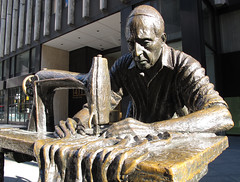NFL Players Protest Indiana "Right To Work" Law

As Indianapolis prepares to host the Superbowl, the state’s Republican legislators and governor are pushing to make Indiana the twenty-third “right to work” state in the nation. On Tuesday, right-to-work legislation advanced to the full state house, despite efforts of Democratic legislators to slow passage of the bill.
Six NFL players from Indiana have spoken out against the bill:
INDIANAPOLIS — Quarterbacks Jay Cutler of the Chicago Bears and Rex Grossman of the Washington Redskins are among six NFL players urging Indiana lawmakers to oppose right-to-work legislation.
Cutler, from Santa Claus, Ind., and Grossman, from Bloomington, joined New Orleans’ Courtney Roby, Pittsburgh’s Trai Essex, St. Louis’ Mark Clayton and San Diego’s Kris Dielman in sending letters to Indiana House members Monday. Days earlier, the NFL Players Association came out against the measure that would ban private contracts that require workers to pay union fees for representation.
Cutler called it a “political ploy” against workers. [AP]
Last year, Democratic lawmakers thwarted the GOP’s attempt to pass right-to-work legislation by fleeing the state. This time around, Republicans have clipped the opposition’s wings by passing anti-bolting legislation that could impose fines of $1000 per day after 3 days of unexcused absence.
[Photo credit: Indywriter, Creative Commons.]










